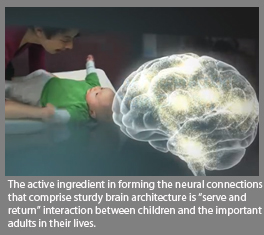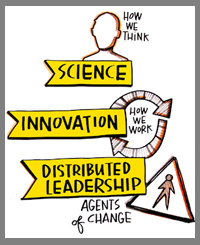Since its designation as Child Abuse Prevention Month in 1983, April has provided a high-profile call to action against child abuse and neglect, and the positive work that organizations are doing to protect children. However, the last decade has seen rapid advances in the fields of neuroscience, molecular biology and epigenetics which have broadened the field’s view of what constitutes child maltreatment and what contributes to a child’s well-being. In recognition of the importance of this greater context, the Center on the Developing Child at Harvard University, a grantee of the Doris Duke Charitable Foundation’s Child Well-being Program, has led the charge to promote understanding of this seminal research and to encourage policies and innovative practices that address important factors built into families’ larger social networks and environments.
“Child abuse early on is a subtext of significant adversity, and that significant adversity is an issue that cuts across all social classes, income groups and racial, ethnic and cultural identities,” said Jack Shonkoff, M.D., director of the Center on the Developing Child. “If we want to achieve breakthrough outcomes for children facing adversity, we have to transform the lives of the adults taking care of them.”
 Reaching both children and adults offers much greater implications for how to improve children’s lives, expanding the burden of responsibility from the child welfare system to the individuals and caregivers who shape children’s lives and experiences. Over the last several years, a strong body of medical research has revealed the lasting damage that child abuse, neglect and other sources of frequent and intense stress can exact on developing brain architecture and lead to ongoing consequences for the child. Despite the gravity of these revelations, a gap was forming: interventions in child welfare were not keeping pace with the advancements in science. Shonkoff launched the Center on the Developing Child in 2006 with an urgent mission to close this gap and improve the life prospects of children by linking research to inform practice. To do this, many different players from research, policy and practice working together were essential to build the support necessary to raise healthy children. At its heart, the center believed that this was a communications issue: that core to their effort was a need to translate this often complex science for the varied set of individuals influencing child outcomes.
Reaching both children and adults offers much greater implications for how to improve children’s lives, expanding the burden of responsibility from the child welfare system to the individuals and caregivers who shape children’s lives and experiences. Over the last several years, a strong body of medical research has revealed the lasting damage that child abuse, neglect and other sources of frequent and intense stress can exact on developing brain architecture and lead to ongoing consequences for the child. Despite the gravity of these revelations, a gap was forming: interventions in child welfare were not keeping pace with the advancements in science. Shonkoff launched the Center on the Developing Child in 2006 with an urgent mission to close this gap and improve the life prospects of children by linking research to inform practice. To do this, many different players from research, policy and practice working together were essential to build the support necessary to raise healthy children. At its heart, the center believed that this was a communications issue: that core to their effort was a need to translate this often complex science for the varied set of individuals influencing child outcomes.
“The challenge has been for all of these fields to come together and accomplish something that’s bigger than what any one of them can accomplish separately,” said Al Race, deputy director and chief knowledge officer at the center. This challenge spurred DDCF to award a $950,000 grant, over three years, to the center to support its communications strategy and overall development and dissemination of knowledge across the field and to new audiences. The center has implemented creative and comprehensive communications techniques to link researchers, practitioners, philanthropists and policymakers together toward their shared goal.
For example, Frontiers of Innovation, one of the center’s most prominent initiatives to drive scientific innovation through collaboration, was itself born out of a collective brainstorming meeting. Sixty-five people, including representatives from the National Conference of State Legislatures and National Governors Association, policy leaders, philanthropists and academics met in 2011 to discuss how more people could gather to try and test new interventions in child abuse treatment. From the very start, it was obvious that “the best people in the field were hungry for new ideas, hungry to interact with others who wanted to push the envelope,” said Shonkoff. The pilot project grew into a strategic, multi-sector initiative that Shonkoff now hopes will drive a broader movement to change the field.
“We didn’t anticipate how fast it would grow in terms of people who resonated to that message,” said Shonkoff. “Now we’ve crossed the river: We’re intent on really changing the landscape of early childhood policy and practice so that it is friendlier to, and in fact demands, continuous innovation rather than just quality improvement.” Seeing this response from the field has also bolstered Shonkoff’s belief that the field “is at a point of maturation, where it’s a sign of strength to say that we want to be better.”
The growth and diversity of the community around the center and its mission for innovative and science-based interventions has only intensified the need for clear and simple communications. Whether practitioner or policymaker, each organization involved with the center brings its own frame for understanding child well-being and terminology with which to conduct research and interpret results. At the same time, none of them operate in isolation, and all benefit from the wider knowledge base of failures and successes of their peers. With the Child Well-being Program’s support, the center has thus worked on building itself into a unifying information source by which organizations stay in tune with the rest of their community and contribute their own findings. It is one way the center has encouraged the rapid sharing of findings across the community, as well as demystifying those findings through appropriate media and messages for different audiences.
 The center’s effort to shift the norm in the field from pattern to progress is evident in the way more and more organizations recently have learned from the science and changed their own approaches. These changes are explicit in the language they use to teach others about the issues at hand. One of the most important breakthroughs for the field was the gradual, widespread acceptance of the notion of toxic stress, the accumulation of adversity, abuse, neglect and/or absence of responsive relationships that can lead to a range of physical, developmental and mental health problems later in life. For years, this critical component remained absent from the national narrative, blocking institutional progress to promote and protect the health and well-being of children and to treat them for abuse and neglect.
The center’s effort to shift the norm in the field from pattern to progress is evident in the way more and more organizations recently have learned from the science and changed their own approaches. These changes are explicit in the language they use to teach others about the issues at hand. One of the most important breakthroughs for the field was the gradual, widespread acceptance of the notion of toxic stress, the accumulation of adversity, abuse, neglect and/or absence of responsive relationships that can lead to a range of physical, developmental and mental health problems later in life. For years, this critical component remained absent from the national narrative, blocking institutional progress to promote and protect the health and well-being of children and to treat them for abuse and neglect.
Now, the efforts of the center and the community it has rallied have helped mainstream frames of thinking about child development step in stride with the reality of toxic stress. “We’re seeing an incredible diversity of people recognizing the reality of toxic stress and early brain development issues,” said Race, “and, as a result, talking about how they might be able to approach child welfare in more effective ways.”
Among the organizations that are now acknowledging the research and evolving their suggested practices are the American Academy of Pediatrics, which in 2012 began to identify toxic stress as a major focus for pediatrics; the Administration for Children, Youth and Families, which began to recognize the harm that intangible psychological and environmental stresses play on children; and the Administration for Children and Families, which has similarly changed its language around Early Head Start to deepen the focus on toxic stress. For the center, these paradigm shifts in the policy and practice world are signals that the field is starting to recognize and act upon the scientific research on detriments to child well-being. This new vocabulary has strengthened a broad-based momentum toward better interventions and healthier children. The immediate future will find the center working on developing real measures of toxic stress; identifying the most critical and sensitive periods of childhood development; and understanding how a child’s environment affects his or her gene expression—research which could contribute to more personalized treatment.
Having seen great progress in the field in just a decade of operation, the center maintains that communications plays a “critical and central role in the impact” of its work. According to Shonkoff, the center is confident that its work to create open and fast-moving communication channels in the community paves the way for practices that are informed by broad consensuses in the science and thus more likely to achieve breakthrough outcomes for children facing adversity. “Storytelling and communication, sharing this innovation experience, presenting what we’ve done and what has been most effective puts us in the position to have a much broader impact on a much larger audience.”
* For more information about the Center on the Developing Child at Harvard University, please visit www.developingchild.harvard.edu.